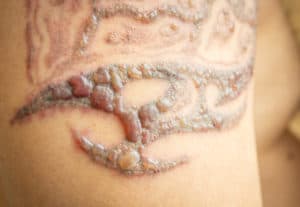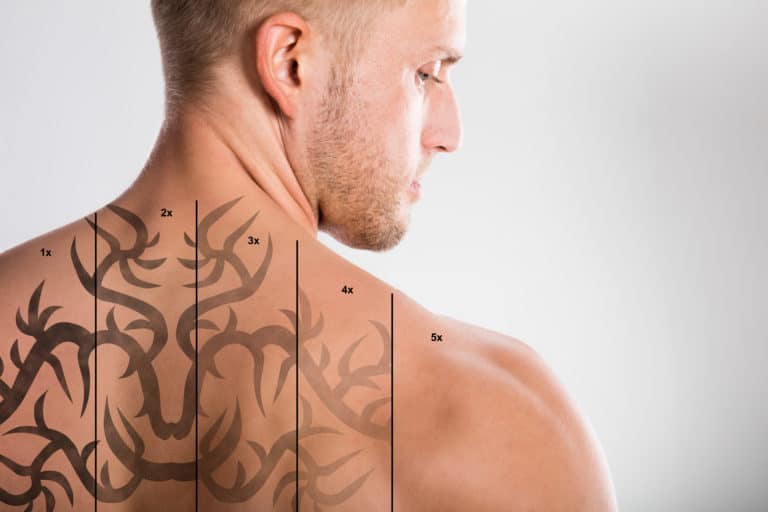Tattoos stay with us for the rest of our lives. It’s why tattoo artists suggest committing to a design and giving it a symbolic meaning before getting a tattoo. Of course, not everyone follows this advice and later ends up regretting their decision.
In this scenario, laser tattoo removal is the ideal process if you want to get rid of a tattoo instantly. Sometimes, a tattoo doesn’t turn out the way you wanted it to, or you might not feel comfortable with it anymore.
This is when laser tattoo removal comes in. It’s a standard process available in almost all parts of the world. After the process, you will experience a few symptoms and side effects in the area, such as swelling and blistering.
It is very common for blisters to appear on your tattoo after completion of the laser removal process. Nevertheless, you can avoid this by following proper aftercare steps.
If you’re experiencing heavy blistering, the main reason would be that you haven’t taken proper care of it. Blistering is a good sign as it shows that your skin is getting rid of the ink.
To learn more about blistering after laser tattoo removal, read further below, so you stay prepared.
How Long Do Blisters Remain Post-Laser Tattoo Removal?
If you experience blisters on your tattoo after the laser removal process, you may have to deal with having them for around two weeks. This also depends on the severity of the blisters and your aftercare routine.
The shortest time they may last is around 8 to 72 hours, and the longest is two weeks. The two weeks of blistering are crucial. In this phase, you have to put in maximum effort to take care of your removed tattoo.
If you experience heavy blistering, it’s best to consult a tattoo artist or a health professional.
How Do You Treat Blisters After Laser Tattoo Removal?
As mentioned earlier, blisters are a common occurrence after your tattoo laser removal procedure. However, blisters are also avoidable by taking the right aftercare steps.
If you’re experiencing heavy blistering on your tattoo area, there are a few things you can do to treat them and lessen the blistered appearance.
Never Pick Your Blisters
No matter how tempted you feel to pick your blisters or even touch them, DON’T! Doing so would only cause more scarring on your skin. Blisters and scabs often appear after the tattoo laser removal process.
To avoid scarring, leave your blisters and scabs alone so they can heal comfortably. Some of the scabs and blisters are still not ready to come off.
If you forcefully pick on them and try to remove them, you could experience a threatening skin infection and excessive pigmentation on your skin.
Use an Over the Counter Ointment
Antibiotic ointments like Neosporin are essential to use after your tattoo laser removal procedure. You must apply this at least three times a day gently on your skin, as these might also help with the excessive blistering on your previously tattooed area.
It would help if you also used a bandage to prevent blistering from happening in the first place and prevent your skin from catching an infection that could lead to more complications in the future.
Use Sunblock
When blisters appear, your skin grows sensitive and prone to different infections. To avoid this, you must regularly use sunblock by applying a thin layer of it on the area of the blister.
Sunblock will help keep your skin soft and smooth, and at the same time, protect it from sun damage, which could worsen the blisters.
Avoid Showering For Too Long
As showering is sometimes unavoidable, but it may not be the best way to take care of your blisters on your tattoo removal area. You can shower, but make sure you don’t stay in for longer than 10 minutes, as exposure to steam your blisters will receive, the harder they may get.
Hence, you should avoid other activities that involve you coming into contact with water. For instance, swimming and other water-based activities. You must ensure this till your blisters heal properly.
Keep the Area Clean
You must continuously keep the area clean to prevent any further infection or blistering. The simplest way to keep it clean is by rinsing the area with warm water and antibacterial soap at the same time.
After washing, make sure you dry the area properly as dampness on the tattoo removal area may lead to other issues.
Use cooling properties
An ice bag would help cool off the inflammation the blisters cause on your skin. Make sure not to leave the ice bag for too long, and don’t all allow the water from the ice to remain on your skin. After you’re done icing, dry the area with a cloth.
Take a Painkiller
Sometimes, inflammation may get quite worse, leading to excessive pain. For temporary comfort, you can take Tylenol along with icing the blistered area. Don’t get too addicted to painkillers as this may also lead to blood thinness; before taking any medications, make sure to consult your doctor.
What Causes Blisters after Laser Tattoo Removal?
There are two main reasons why you may experience blistering after the procedure. One reason is that your skin is improving, and the tattoo is fading away successfully. The main point of the procedure is for the skin to get rid of the tattoo.
If you experience signs of blisters, it’s a good indication that your skin is going 
This is why getting blisters after the procedure isn’t a very alarming thing, and all you have to do is let it heal itself without fidgeting with it.
The other reason why you may experience blisters is poor aftercare. As soon as you’re through the laser tattoo removal process, you have to follow proper aftercare guidelines, which you will receive from your tattoo artist, who completed the laser removal process.
These guidelines consist of simple cleaning steps that will prevent you from developing blisters in the first place, or if you already have them, you can prevent them from worsening.
Failure to take any of the steps since day one will eventually lead to scabbing and blistering, which sometimes, with time, may get worse.
If you experience blisters, make sure to consult a health professional immediately. In rare cases, it could be something threatening, such as an allergic reaction or something that didn’t go right in the laser tattoo removal process.
Are Blisters a Sign of Infection?
Blisters can develop due to different reasons. You’re already aware of the reason for blisters occurring after a laser tattoo removal process, but sometimes, these blisters could worsen over time, leading to an infection.
If you continue to remain reluctant about aftercare, even after your blisters appear, then you’re asking for trouble. Blisters are one of the main symptoms of infections such as chickenpox and impetigo, a bacterial infection in the skin.
While blisters are a common occurrence after the laser tattoo removal process, it’s possible that you have developed an infection, or it could be just a great coincidence.
Regardless, an infection is a serious sign, and you must immediately get in touch with your doctor if you notice excessive blistering. They will help figure out if you have an infection or it’s only because of the laser tattoo removal procedure.
To keep yourself infection-free, it’s best to know for sure that you want to go through the laser tattoo removal process, and if you decide to go, make sure you practice effective aftercare.
Can I Apply Makeup On The Blistered Area?
Your skin might start to look ugly once you develop blisters, but these go away within time once your skin fully heals after the laser tattoo removal process.
This will tempt you to apply makeup on the blistered area, but avoid doing this for a while. The moment you apply makeup, there is a big chance you will develop an infection, which may cause more compilations for your skin in the future.
Instead of applying makeup, use ointments to soften the skin so you get some relief from symptoms such as itching. The most you can use is sunblock, which is quite important to prevent any further damage by sun rays.
Final Thoughts
Seeing blisters grow on your skin after your laser tattoo removal process may be one of the scariest experiences. Nonetheless, you should know that it’s not as big of a problem, as blistering is a common symptom appearing after laser removal treatment.
Make sure to regularly clean the area after completion of the tattoo removal process. This will keep you avoid infections and suffering from blisters in the first place.

